TLDR: I’ll share with you unconventional but ridiculously powerful chiropractic marketing strategies. I’ll also cover common pitfalls to avoid when marketing your practice.
Most chiropractic marketing strategies work backward disregarding vital parts of your business. In this article, I’ll lay down some common traps when marketing your chiropractic AND other unique ways you can market it.
This article covers:
- Common Mistakes to avoid when marketing your chiropractic
- Developing Brand DNA
- Brand Positioning and Developing your differentiator
- What is Optical Communication Strategy and how to use it?
- Using Brand Voice Strategy and Social Media
- Brand Storytelling Strategy
- Email Autoresponder Strategy
- Increasing your sphere of influence using public speaking
- Podcast Tours and how to create consistent traffic from multiple podcasts
- Other marketing strategies (honorable mentions)
Without wasting too much time, let’s start.
Why Most Chiropractic Marketing Campaigns Fail
Let’s take a proactive approach and go through common marketing mistakes so you can avoid them.
1) Lacking a strategic purpose articulation
People don’t buy what you do; they buy why you do it
― Simon Sinek
Gone are the days where medical businesses offer a robotic value offering marketing messages and wait for patients to come in. Today’s patients expect more from your brand. They want purpose-driven communication. A communication that is infused with purpose and noble cause.
And if your brand’s marketing is filled with the same sounding automated messages, it’ll be stored in your patient’s “Meh” part of the brain.
We take sides with brands that have a mission to fulfill, a purpose to serve, and a grounded vision to follow. That’s because we value meaningful ventures and relationships.
If a chiropractic brand is on a mission to enhance the quality of life ( The Joint Chiropractic), why would I go to the “affordable chiropractic office”?
“I have a mission, vision, and purpose statement is that it?”
These statements are tossed around a lot. Most of which are used as a decoration to an about us page instead of a compass for a practice to follow.
To know if your practice is purpose-driven ask the following questions:
- What makes my mission statement different?
- Is my purpose maintained and integrated into my business?
- Is my vision strategic and practical? Or is it just wishy-washy claims?
- Am I strategically vocal about my business values?
- How integrated are my values in my business processes?
- When patients go out of the door, will they know what our brand stands for?
If you don’t have answers to all of these questions, I’ll share with you the solution in the next section where we discuss how to develop your brand DNA.
2) Is your chiropractic marketing adding to the clutter?
With the flooding wellspring of brands, businesses are popping up by the second, fist-fighting for your would-be patient’s attention.
Your competition does not come from other offices, indeed, but from the clutter.

The average person encounters between 6,000 to 10,000 ads daily. All from the same sounding brands, providing the same sounding offers with the same sounding voice.
And our brains deal with this clutter the best way it knows how—by blocking most of it out.
We created an unbreachable wall against the never-ending marketing messages by filtering out what’s uninspiring, lookalike, or straight out drab. These walls act as mental boxes in our heads to store ONLY the interesting, different, and vibrant.
According to research conducted by Read Montague, Professor of Neuroscience, strong brands have the power to own a “box” or a piece of our frontal cortex.
Being radically different is the only way to cut through this clutter. It is your ticket to secure a seat in your patient’s mental boxes of “brands to remember”.
So, before marketing, ask yourself, does our marketing messages look the same as everyone else’s? Are we adding to the clutter?
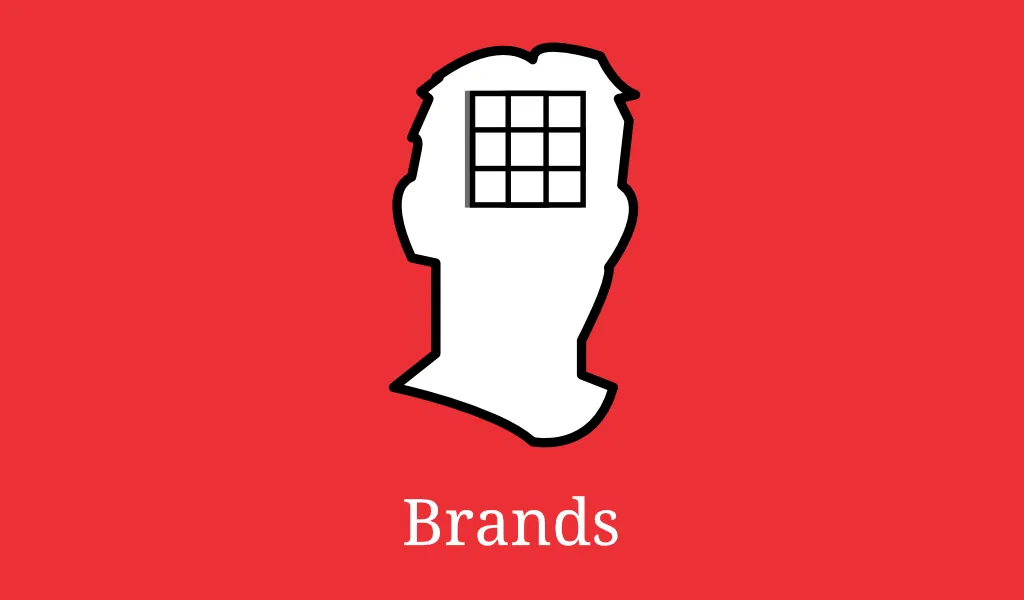
3) Embarking on a vision-blind marketing campaign
Marketing a practice for the sake of increasing patient volume or growing profit margins is insufficient. These are the poor man’s success metrics.
You need a business vision that goes beyond the “time-bounded” growth indicators. Most chiropractic marketing campaigns over-invest in short-term gains (quarterly revenues, ROI, volume) while incurring a long-term loss of their identity (patient loyalty, brand equity, brand preference).
The vision you put in place must account for future stability for your practice and decreased marketing costs. To do that you also need to change your success measurability.
We shouldn’t be slaves to the growth curves. Instead of focusing on the short-term indicators, we must reroute our attention to more meaningful ones.
To learn more about future-proof metrics, check this guide .
4) Misalignment between the marketing and the patient experience
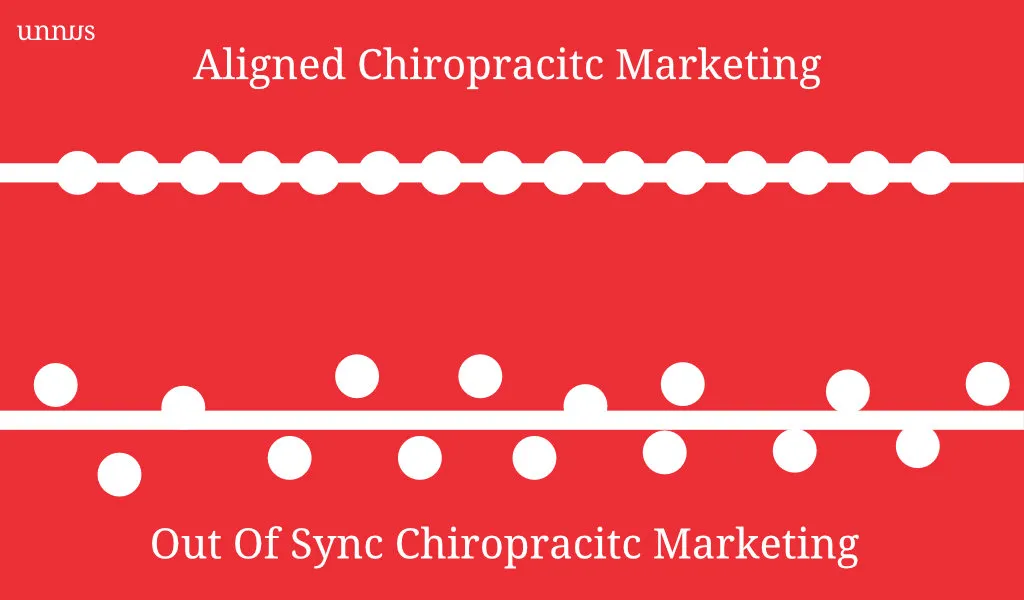
A common trap Marketers fall into, is that the marketing is not in sync with the patient experience. Marketers get caught in increasing the patient volume and outright disregard the consistency of the campaign.
Consistency is critical. From the first encounter, your patient has with you until they get out of your office, everything needs to vibrate at the same frequency.
If you skew from what you promised in the marketing, your brand gets diluted and patients feel the inauthenticity. A poorly thought campaign that does not take your business’s philosophy into account will be prone to create mixed signals.
Chiropractic Marketing strategies
Let’s check some interesting marketing strategies.
1) Developing a Brand DNA

Brand DNA is the credo of your chiropractic brand. It is the true north that directs your practice. Brand DNA consists of three elements: your why, how, and what. The “What and how” is what you do and how you do it. And the “Why” is the reason for the practice to exist.
Sounds simple? Not really.
In his book, Start With The Way, Author Simon Sinek suggests that most businesses know what they do, and how they do it, but few know why they do what they do.
Why do you do what you do besides making a profit? Why would anyone care? And are you vocal about it? These seemingly easy but surprisingly hard to answer questions are the difference between ridiculously loved brands and average commodities.
Businesses who can articulate their Why to their audience enjoy cult-like following, automatic repurchases, and soaring patient retention rate.
That’s because when you communicate with purpose-backed messages, your marketing is perceived by the limbic system, the part of the brain that is responsible for emotions, and decision making .
Purpose-backed messages are marketing messages that are infused with a high sense of mission, jargon-free, and illustrate your business’s purpose. We also call them Why Messages.
Communicating with Why Messages differentiates you from the rest.
To help you see the difference, let’s take two different pitches, one is a Why message, and the other is a basic value offer pitch (A What Message).
#~First, What Message (basic value offer)
We’re Athletim, we provide personalized natural care through our comprehensive health and wellness plan. We help patients unleash their potential and live a pain-free lifestyle.
It states who they are, and what they do. Great. It also explains how this benefits patients. Let’s see how the pitch will look like when your “why” is well articulated.
#~Second, Why Message (purpose-infused communication)
What good is a lifestyle if it’s restricted, stifled by discomfort, and not lived fully? Our practice was founded to free people from these layers of limitation. We believe everyone has the aptitude to accomplish greatness if they can harness their potential. We’re Athletim, we peel off physical restriction, pain hindrance, and help you lead an anxiety-free lifestyle.
The second pitch doesn’t sell you what they do. They’re selling you why they’re doing it. This tightens the relationship and loyalty for the business and transforms its perceived value (a.k.a brand equity).

If you’d like to know how you develop a DNA and integrate it into your marketing communication, Here’s a free guide to implement it within your business.
2) Developing a Brand Positioning Strategy
A positioning strategy aims to develop a key element that differentiates your chiropractic brand. And your positioning is where your business stands in relation to other brands.
To illustrate, I’ll use an example from a Netflix series called Better call Saul.
In one of the episodes, the protagonist, James Mcgill, had to work in a mobile store where there are no customers whatsoever.
The branch James worked in sells the same phones as every competitor. There was nothing that merits his store.
Fed up with this, one day, James painted on the store’s frontend the following statement:
“Is The Man Listening? Privacy Sold Here”
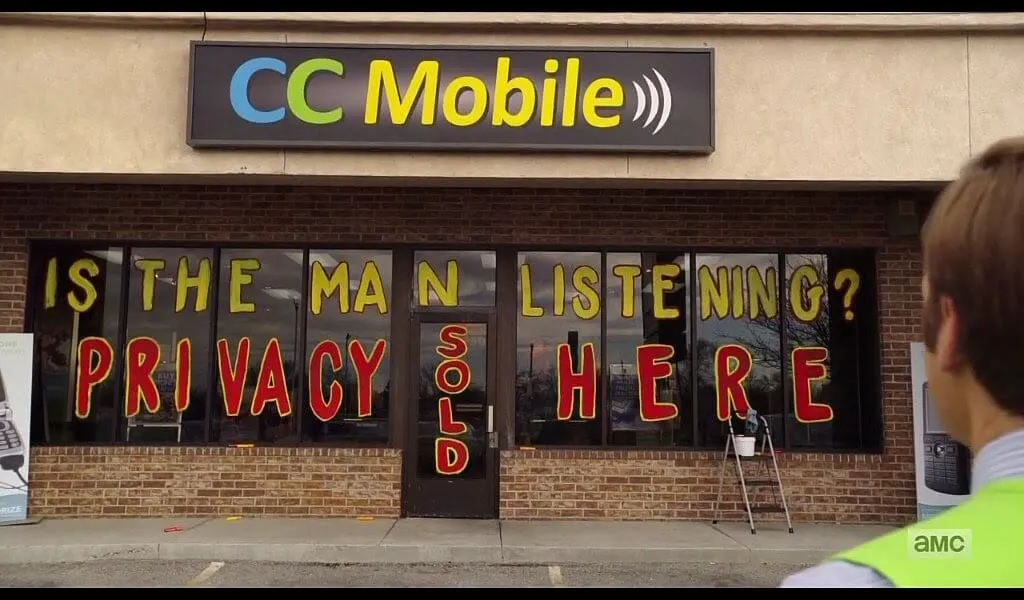
While you can buy the same phone somewhere else, James sells privacy. He differentiated the store to be the only store that sells privacy to its customer.
He knows that his surrounding area is full of drug dealers and smugglers. So The statement “Privacy sold here” resonates with people that want to keep a low profile.
Although this is a fictional story, the concept it presents holds true to real-life marketing.
But before we dive into the “how”, I want to drive home a concept many might find counterintuitive. And that is focusing your business.
#~To focus or to defocus: is your practice focused enough?
An unfocused brand is one that’s so broad that it doesn’t stand for anything. A focused brand, by contrast, knows exactly what it is, why it’s different, and why people want it.
― Marty Neumeier
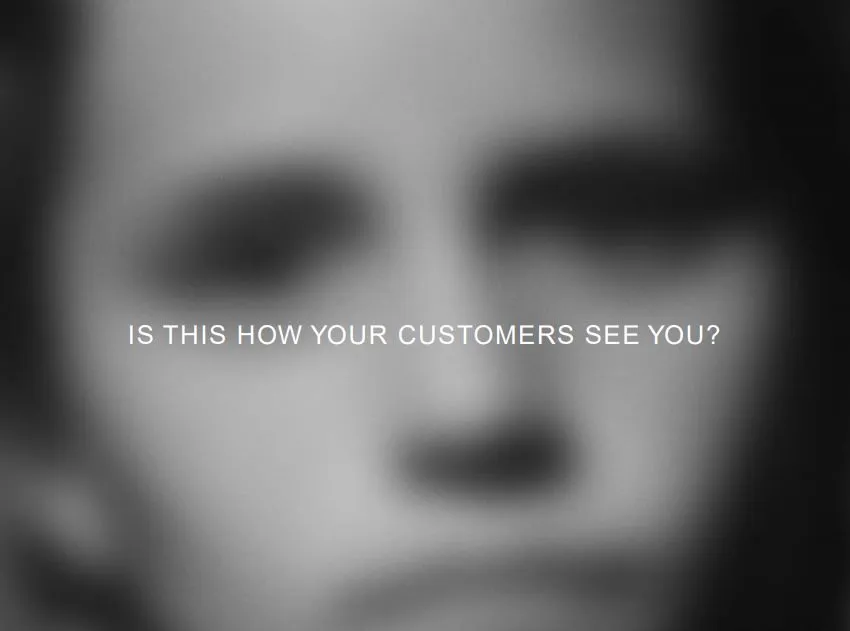
In his book, The Win Without Pitching Manifesto, author Blair Enns calls positioning “The Difficult Business Decision”.
And it makes sense.
Many when asked to focus their brand to serve specific kinds of people with specific kinds of offers, think it limits their outreach.
An example of focusing is being a practice that focuses on pediatrics. It might sound restricting at first, After all, If we narrow our offering, won’t we narrow our opportunities for profit? Answer: Not necessarily.
History has shown that it pays handsomely to be number one in your category—first, because of higher margins, and second because the risk of commoditization is almost nonexistent.
The exact opposite of this is what we call brand dilution: when you try to be everything to everybody and windup like every other practice. By being broad, you defocus your brand and leave it up to would-be patients to decide where to go.
If there are multiple chiropractic offices, offering the same services, for the same patients, why should they choose you? Better equipment? Can be bought or as easily acquired. Better quality care? Everybody claims so. Affordable? Well, you run the risk of participating in a race to the bottom.
Focusing your brand could be also about how you deliver your care and not the people you serve. Maybe you’re the most convenient chiropractor. Or your practice is focused on same-day care and being the fastest service in your domain for busy people.
Focusing the brand to serve specific people with specific needs is what sets you apart and gives it clarity. It is a declaration of authority and expertise.
Now, with that out of the way, let’s position and try to focus our earlier example, Athletim™.
#~The process to conduct a positioning strategy for your practice
The positioning strategy consists of 3 stages:
- Audience Persona
- Differentiator Development
- Onliness Statement Development
Let’s tackle them one by one.
1) Audience Persona
In this stage, we stress your ideal patients and their characteristics. Knowing your target audience lets you connect and align yourself with their needs more deeply.
To get a firm understanding of your target audience we’ll use Audience Persona Exercises™.
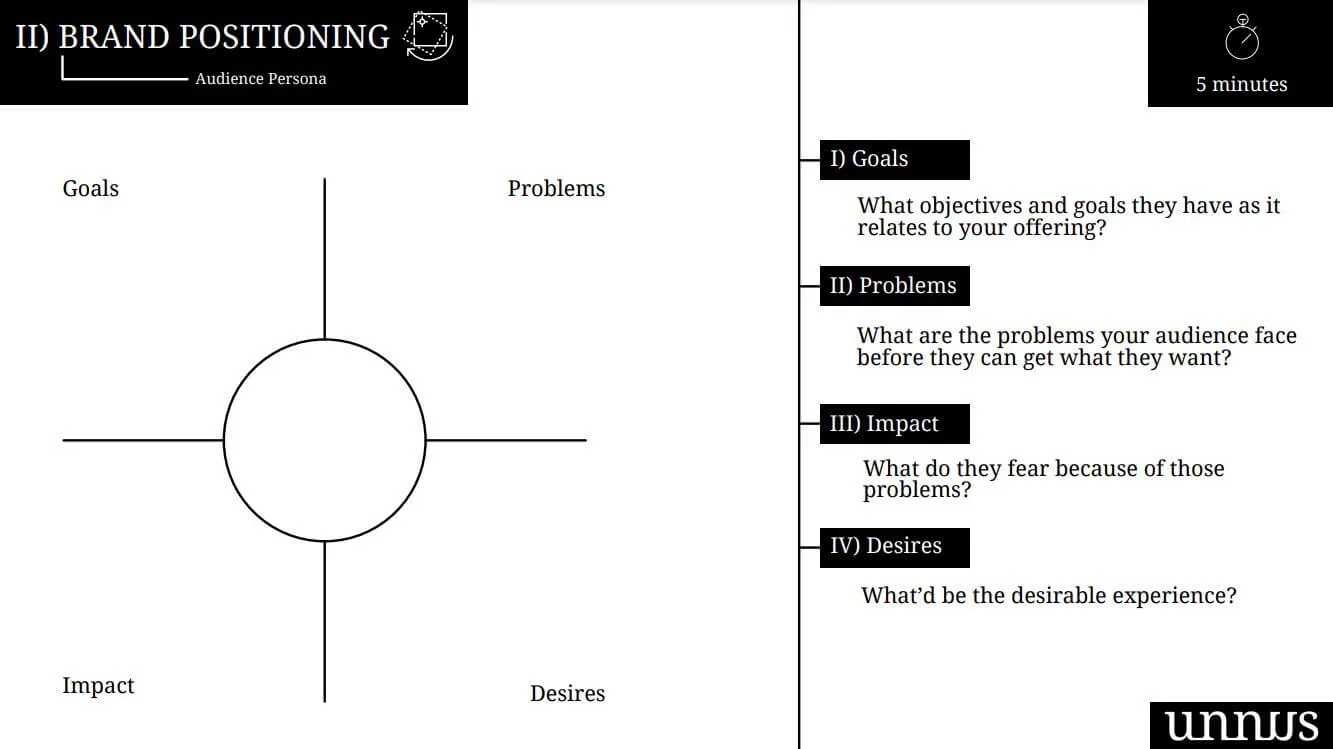
You can download PDF or print this exercise for free here .
The team over Athletim™ chiropractic has years of experience working with athletes and athletic injuries, so they decided to focus on athletes and gymnasts.
Now we have a rough idea of who we’d like to serve, let’s plot their wants and needs in the Audience Persona Diagram.
Ask yourself and your team the following:
- For goals: What objectives they have as it relates to your offering?
- For problems: What are the problems your patient faces before they know you?
- For Impact: What do they fear because of those problems?
- For Desires: What’d be the desirable experience? What would be the best-case scenario after they get your treatment?
Write down the answers in sticky notes and place them in their respective quadrant. If you’d like to perform this workshop online, you can use Miro with your team, it’s easy and free.
Once you’ve done that, circle the important findings to describe your target audience in 1 or 2 short sentences.
For Athletim™ the result will look something like this:
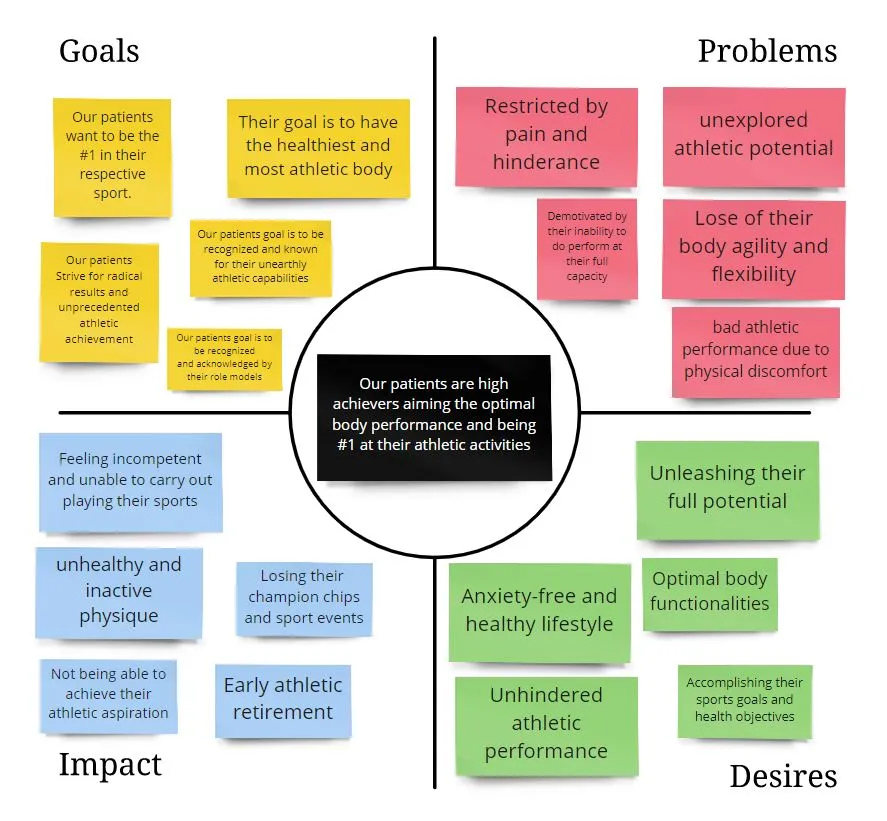
2) Differentiator Development
After knowing your audience, it’s time to develop a differentiator. And for that, we’ll use Brand Differentiator Graph Exercise™ (BDG).
The BDG helps you achieve the following:
- Plot potential unique value offers or differentiator, And;
- Evaluate your possible differentiators based on how important they are to your patients and;
- To check whether or not the competition is using the same differentiators.

You can access this template for free here .
Furthermore, the graph is split into four sections:
- Unappreciated efforts: This section holds everything that most of your competitors have and is of little importance to your patient. Having an about us website is of no practical use to your patient. And every competitor mostly has one. So it’s an unappreciated effort if you have one.
- Fulfilled priorities: This section holds critical parts of your chiropractic business such as a good office space. It is important for your patients but it doesn’t set you apart per se.
- Secondary differentiators: Here are aspects of your business that are different and most competitors don’t have but they don’t add value for your patients. For example, an online booking system.
- Primary differentiators: These are differentiators that are key to your success. Because they add high value to your patients and your competitors do not have this unique aspect. For example, if you’re an expert at pediatric injuries and most of your competitors don’t have the experience you have.
On the x-axis is how important the differentiator is to your patients. On the y axis is how prevalent this differentiator is in the competitive landscape.
Brainstorm possible differentiators and writing down on sticky notes possible unique aspects about your practice or a different approach to your service.
If you don’t have a unique aspect, in particular, try to think of how you can outmaneuver everyone and take another approach to your practice.
A few questions to give you a head start:
- What does our practice do differently and exceptionally well?
- What are the unmet needs that patients are experiencing in the chiropractic field?
- What do our competitors do mediocrely?
- What are some of the chiropractic industry “standards” that we can diverge from?
- What sort of luxury patients are not aware of, that could elevate their experience?
Write all of the possible ideas and start plotting them on the BDG.
Athletim™’s graph will look something like this:
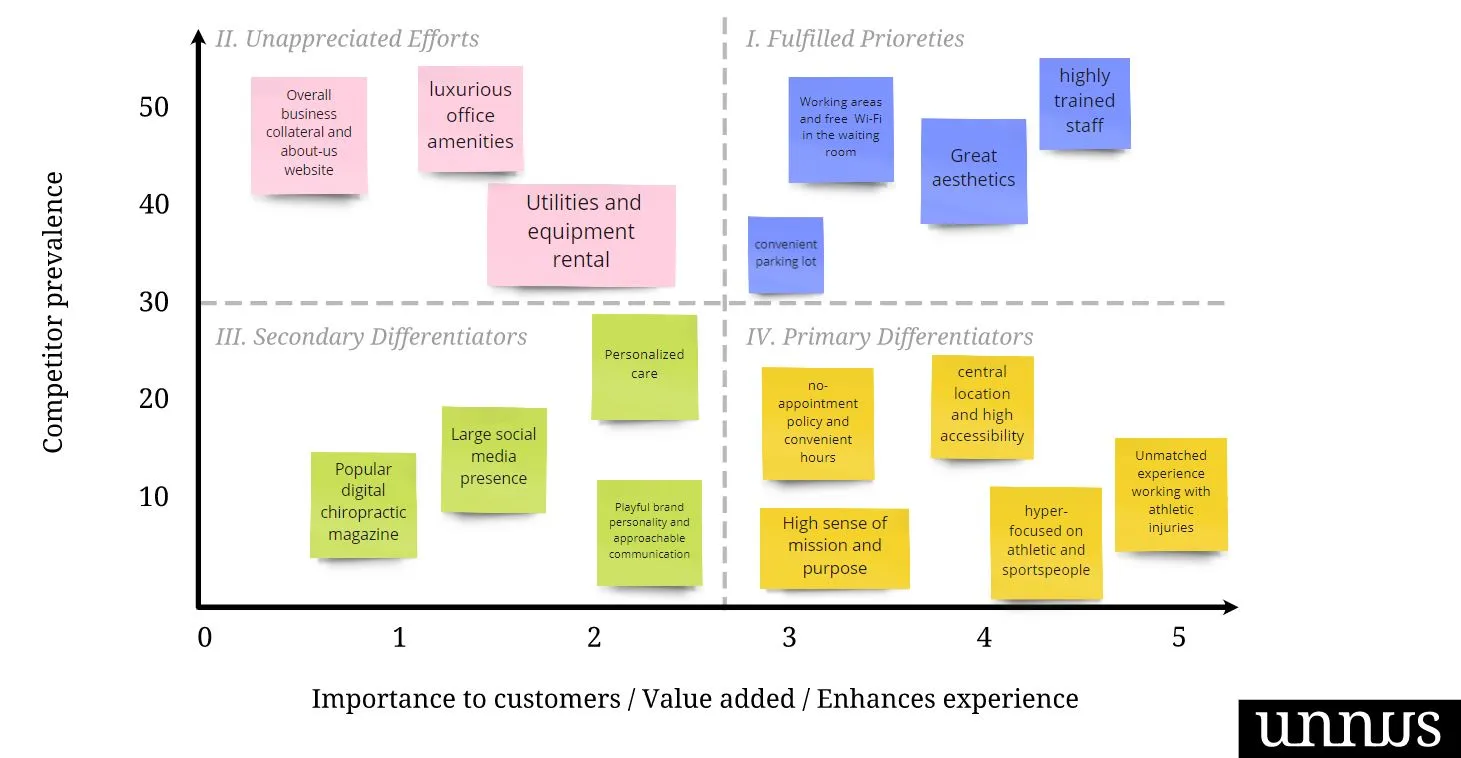
3) Onliness Statement Development
Onliness Statement is a positioning statement that radically differentiates your practice and gives it a razor-sharp clarity. It’s simple yet the hardest part of the positioning strategy.
The onliness statement declares the only thing that your practice does uniquely and no other competitor can claim.
We’re going to use Onliness Statement Exercise™ and sticky notes to finish this strategy.
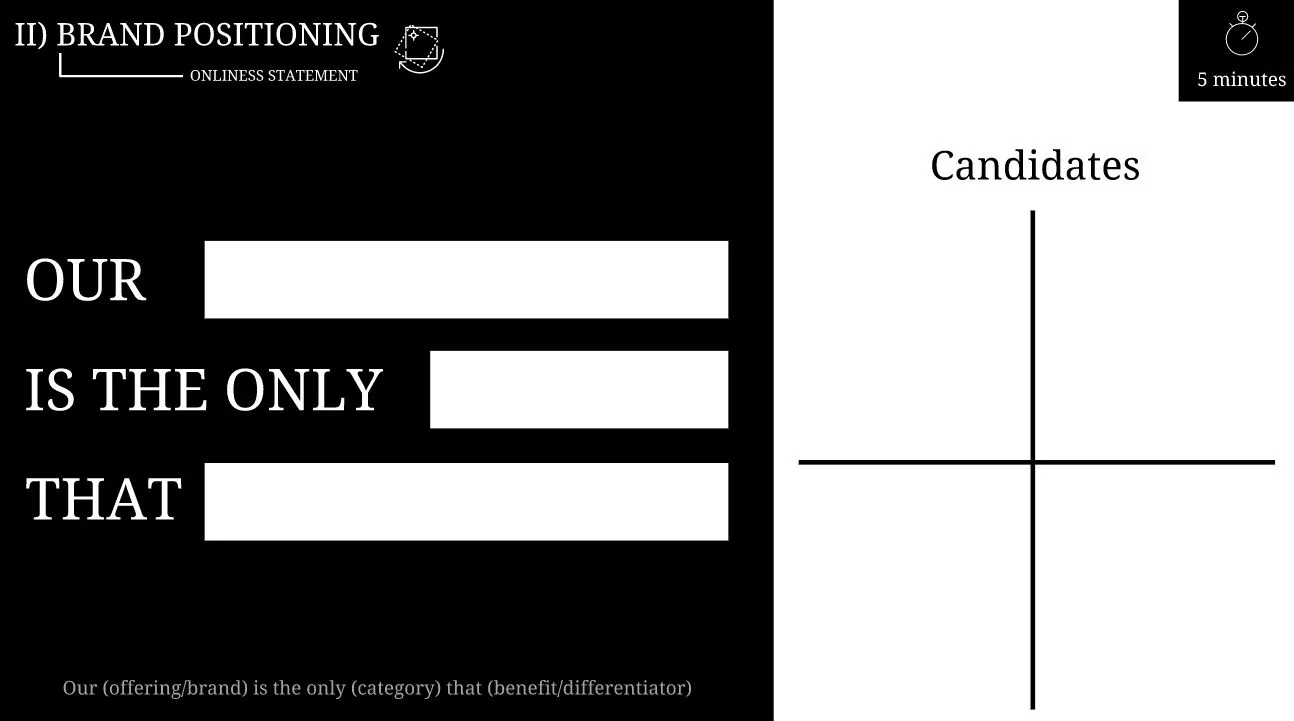
You can access this free exercise here .
The template of the statement is as follows:
Our [Offering/Brand] Is the only [Category] That [Differentiator].
And here are examples from our clients to take inspiration from:
Odentia, Pasadena-based dental practice slashes the dental horror show that patients are afraid of with their onliness statement.
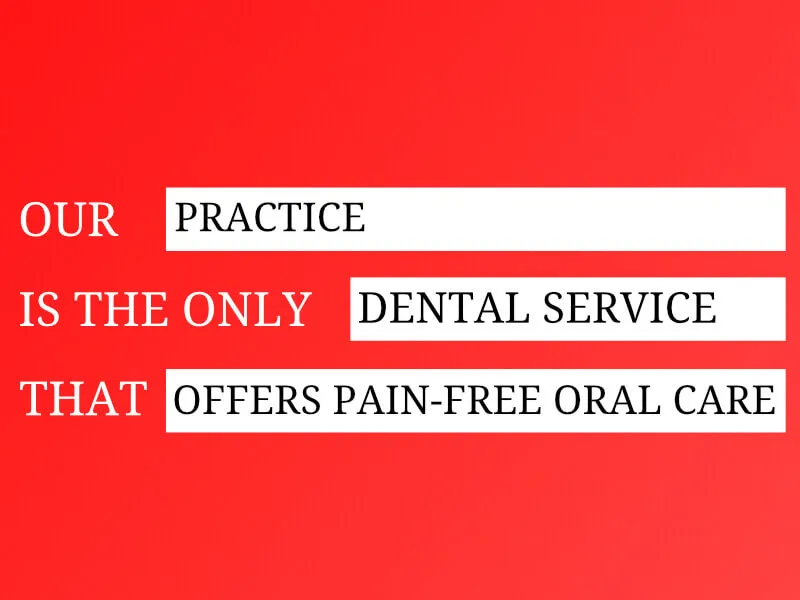
In the age of malpractice, Healthier, an Orlando-based hospital, took a stance by positioning their hospital as the risk-free care center.

Let’s see how this will turn out with our chiropractic example, Athletim™.
First, take inspiration from the Brand Differentiator Graph™, to finish the onliness statement. It is better to take primary differentiators from the graph because they are already unique to your business.
On the right side of the Onliness Statement Exercise template, there are four quadrants where you can stick candidates’ statements. After you and your team gather a few ideas, vote on which one is the most suitable for your practice.
Athletim’s Onliness Statement:
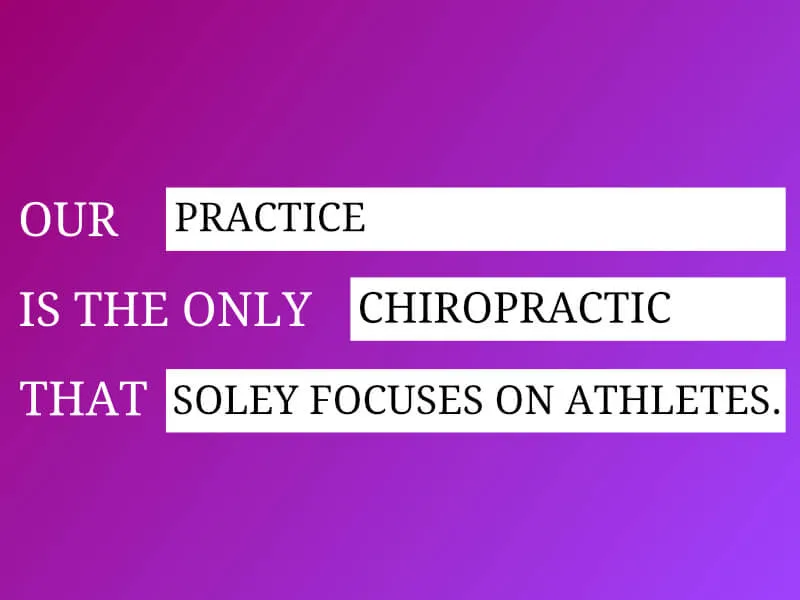
3) Optical Communication Strategy
In an age of time-poor and information-rich patients, aesthetics are the language of the future. Despite our bias towards imagery, visuals are the most underutilized aspect of marketing in the chiropractic field.
Rifle through any chiropractic brand and you’ll notice the pattern of the predictable logos, lookalike colors, and the endless icons of spine symbols.
Everything looks the same you wonder why people bothered designing a logo to create distinction.
Visuals should convey meaning, message, and your positioning in the market. They should never be a derivative of “what’s already out there”.
The Optical Communication Strategy (OCS) aims to slice through the “me too” aesthetics and present your differentiators using art direction.
This strategy will overhaul your visual identity (Logo, Web Design, Referral pads, Office Design, signage, etc..). It also creates a consistent identity that mirrors your brand’s positioning and philosophies.
So, how can you portray these attributes visually to potential patients?
Optical Communication Strategy: The step-by-step process
I’ll use one of our clients as an example of this process. The following guide is one that we applied here at unnus with Confidental, a dental practice based in Napa Valley. But the same can be applied to your chiropractic practice.
Confidental™ noticed that their competitors are squeezing the air out of the “have-a-better-smile” statements.
So, to differentiate their brand, they put a brand strategy in place.
During the branding workshop, we spot an insightful observation:
Most of the patients didn’t book a visit to get “premium oral care”. They went to the dentist because they wanted to eradicate self-consciousness.
Sure, a crooked or chipped tooth is a “reason” for why they went there. However, getting rid of that issue is a means to an end—to be more confident in their dental appearance.
Knowing this, we positioned Confidental™ as the only dental practice that prioritizes its patient’s confidence.
The Confidental™ brand stands for:
- Confidence and certitude
- Fostering self-regard for its patients
- Assurance and reliance
Now to convey their philosophy and communicate their positioning visually, we conducted an optical communication strategy.
The OCS consist of 3 stages:
- Brand Keyword Disbandment (BKD)
- Visualization
- Creative Process
1) Brand Keyword Disbandment (BKD)
In this stage, you gather up all the keywords that are related to your brand and categorize them as seen below.
In the case of Confidental™ Brand keywords will look like this:
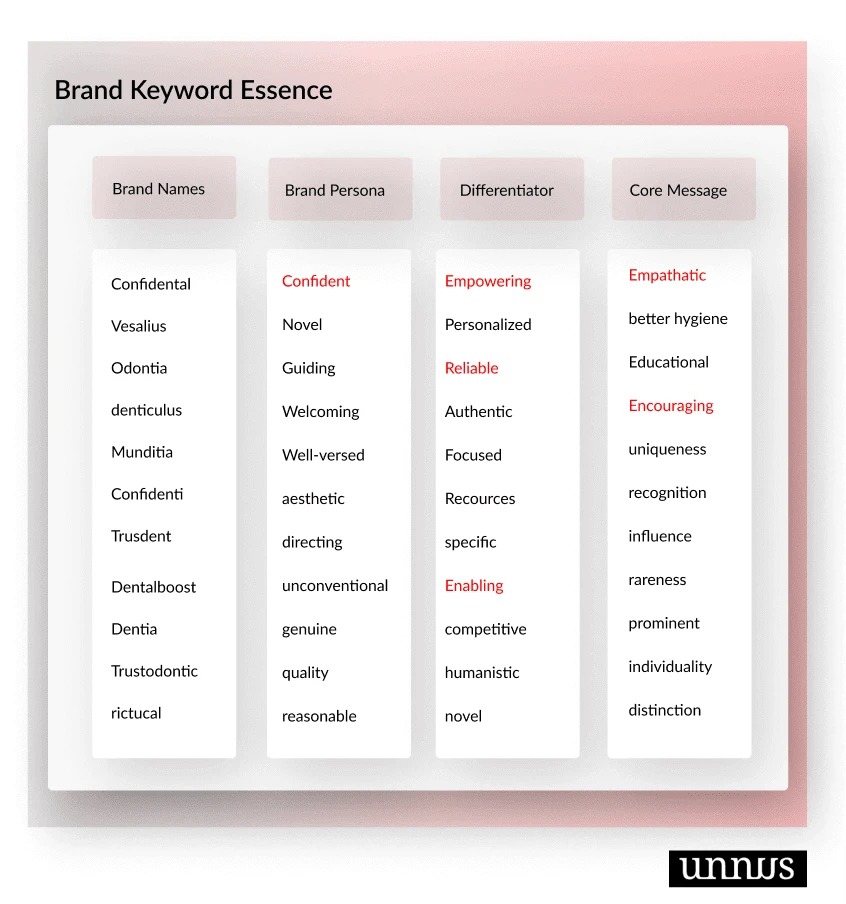
Each column represents a different element of their brand and the keywords that are related to that element.
After that, highlight 3-6 keywords that represent your medical business and its positioning.
In this case, Confidental™ has 6 keywords that encapsulate the whole brand: Confidence, Enabling, Empowering, Reliable, Empathetic, and Encouraging.
To save time, we’ll use 3 keywords and move on to the next process.
2) Visualization
Next, we take the 3 keywords from the last step and give them a visual aspect.
Think of it as putting a “dress” on these keywords.
You see, here is where meaning intersects with design.
For example, the visual aspect of the word “class” will be as follows:
- Physical: “class” indicates that something is Elegant Looking.
- Emotional: “class” gives the sense of a Charm or Politeness.
- Descriptive: “Class” describes the Traditional feel.
We then apply this technique for each keyword we chose:
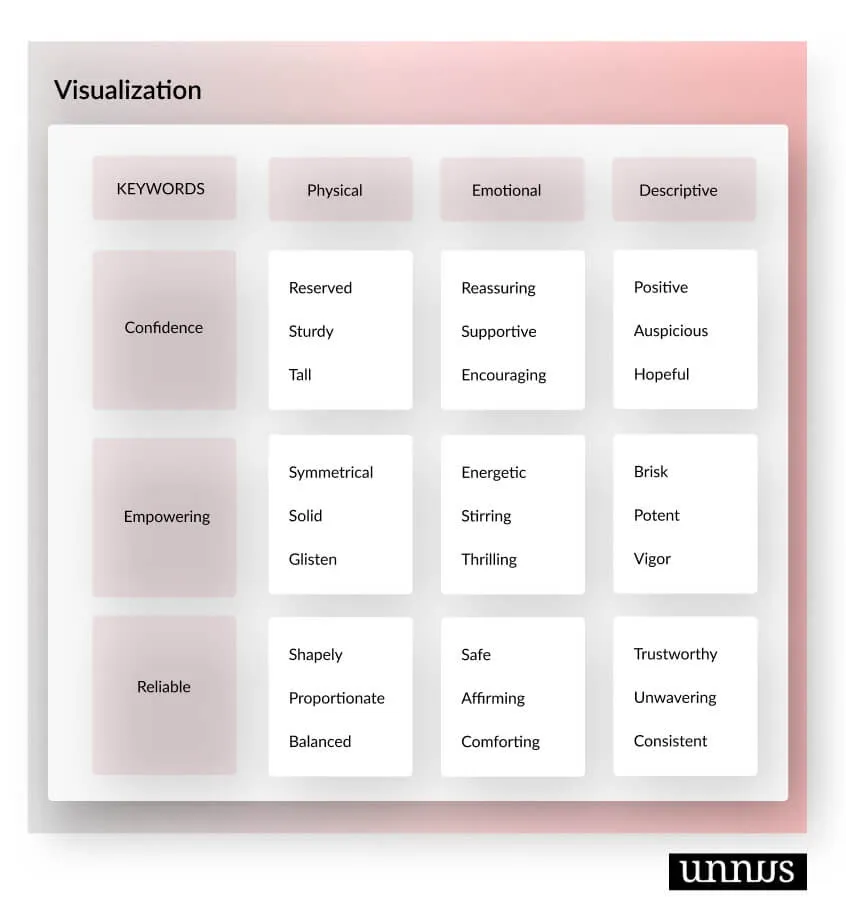
3) Creative Process
Now that we have the general sense of how Confidental™ visual identity will look like, let’s go into the creative process.
In this stage, your team will decide how your external branding (visual design) will look based on what your brand means to your patients.
Things like logo, website, business cards, images, videos, collateral, office space, etc.
Each one will carry a little substance of your brand and express it to your patients in a visual way.
We’ll take the visual aspects of your brand’s most representative keywords (which we got from the last step) and create a general theme for using all of them.
Confidental™ outlook theme will look something like:
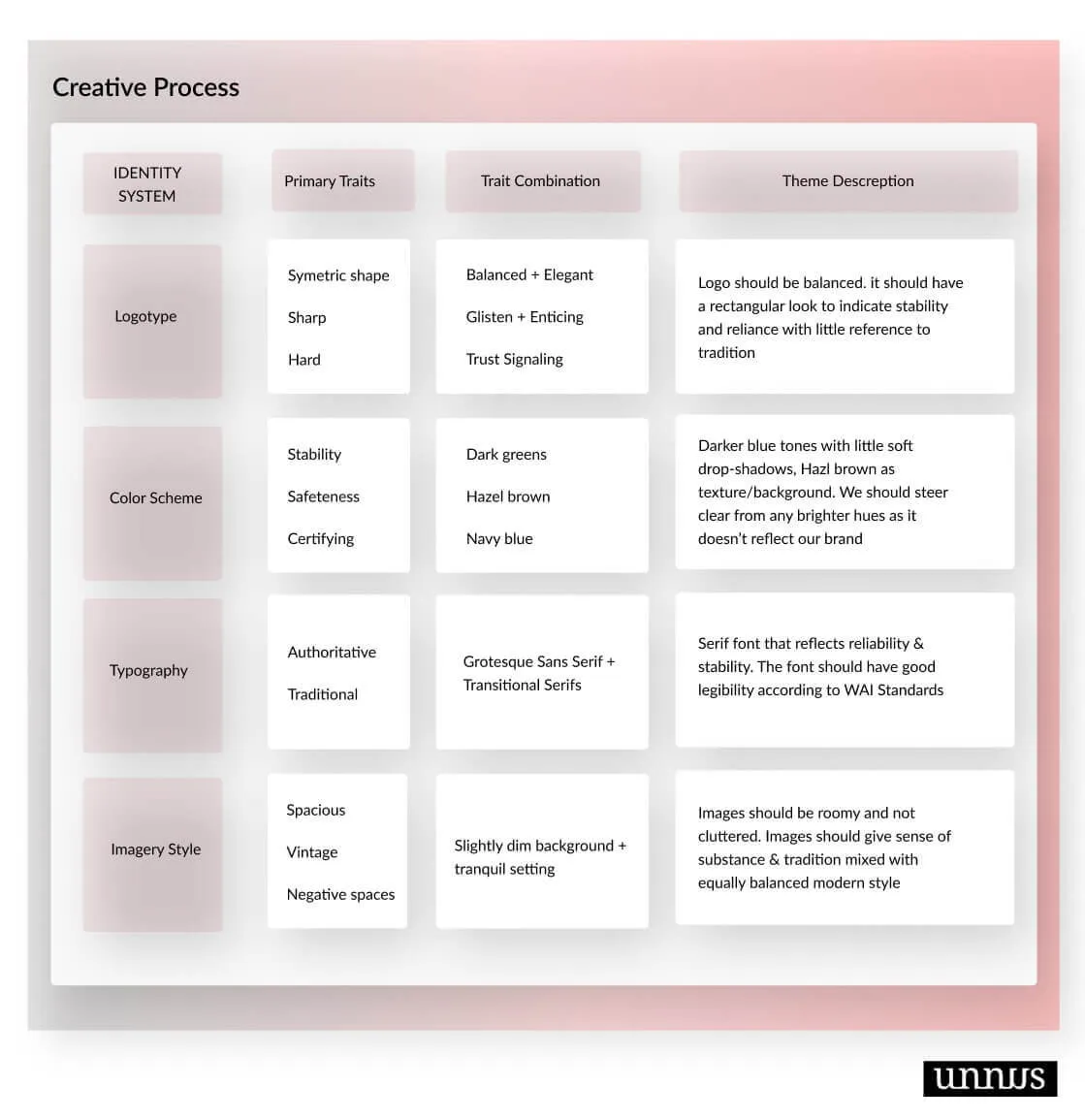
After that, you can hand this art direction to your designer and your visual identity will be tailored to your practice.
And best of all, your identity carries with it meaning. It’s not a “yet-another-chiro-brand” kind of work.
4) Using Brand Voice Strategy With Social Media
Many consider social media as a “nice to have” rather than a channel to acquire patients. What muddies the waters, is the dull “updates” or “we’re closed” kind of posts. Some businesses try to improve on this and share “quotes” and fun videos on their pages.
But, do people care? Most likely not.
Here’s the thing: People won’t share or engage with anything online unless your content has the following attributes:
- Your posts make your audience look good (“If there’s a post, that if I shared, compliments me or makes me look good, I’ll share it”)
- Your posts speak to your audience deeply (If you speak to your audience in a deeper level on social media, your engagement will skyrocket)
- Your posts are fun. (People on social media are there to have fun, make their day with a joke that only they can understand Or with an interesting status)
- You have a unique voice for communicating with your audience. (There’s no shortage of boring social media posts, to be memorable, your tone must be grabbing and appealing.)
- Your posts are useful for your audience
Before we get into the strategy that checks all of the above, let’s see some good examples of brands that have a unique voice in social media.
Examples of brand voice:
#~The Joint Chiropractic: Their voice in social media is laid-back, casual, and uplifting.

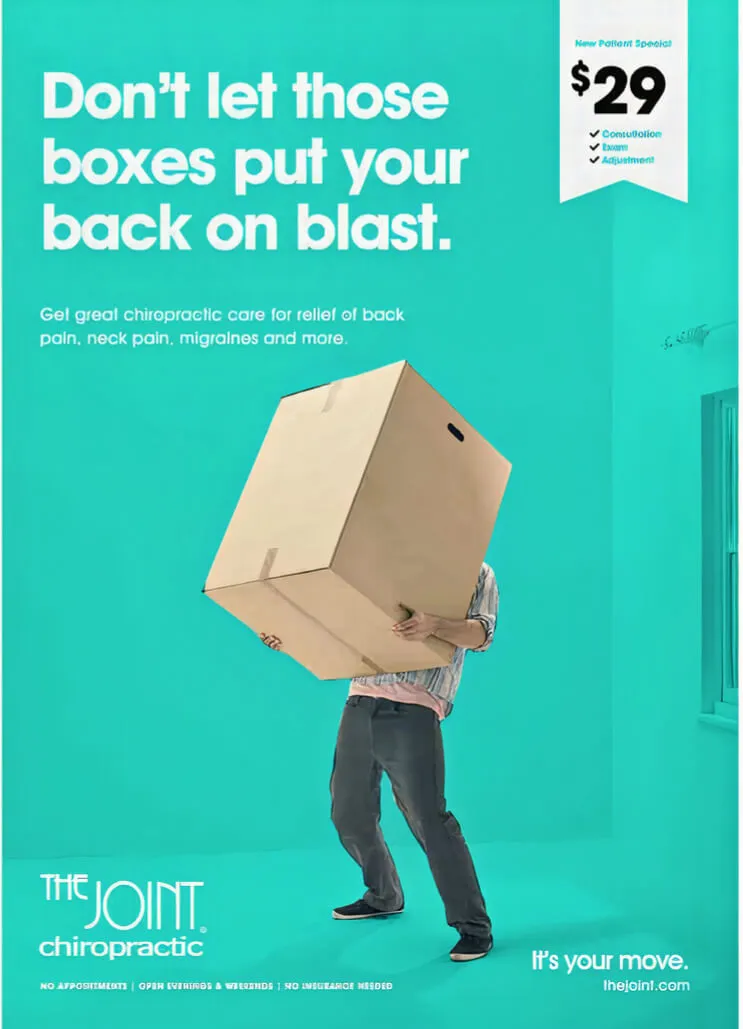
Their Brand Voice is consistent in their Facebook page

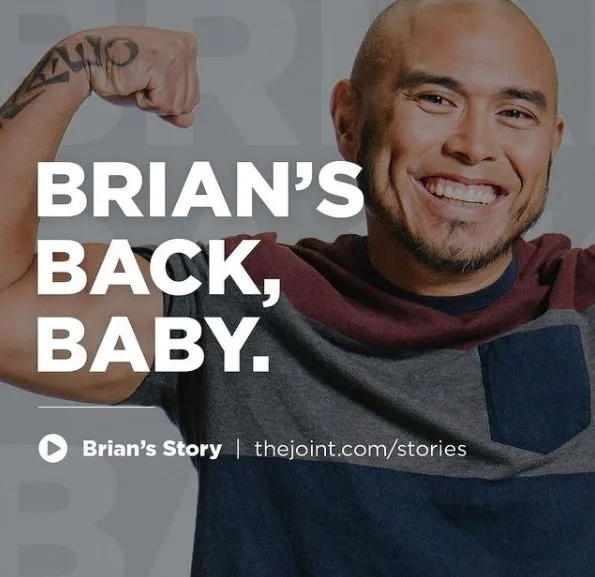

#~Fridababy, Their voice in social media is frisky, humorous, and unsolicited.

#~The Economist (non-medical example), a weekly newspaper that focuses on current affairs, international business.
The Economist’s audience is mainly C-suite executives and founders. Notice how relatable communication is to their audience.



Brand voice is not only used in social media, it can be used across all of your touch-points with your patients.
Here’s an example of the unique voice of a mobile app from the Desk Magazine. Although the weather app market is saturated, AuthenticWeather tries to slice through the “me too” apps by their witty communication.


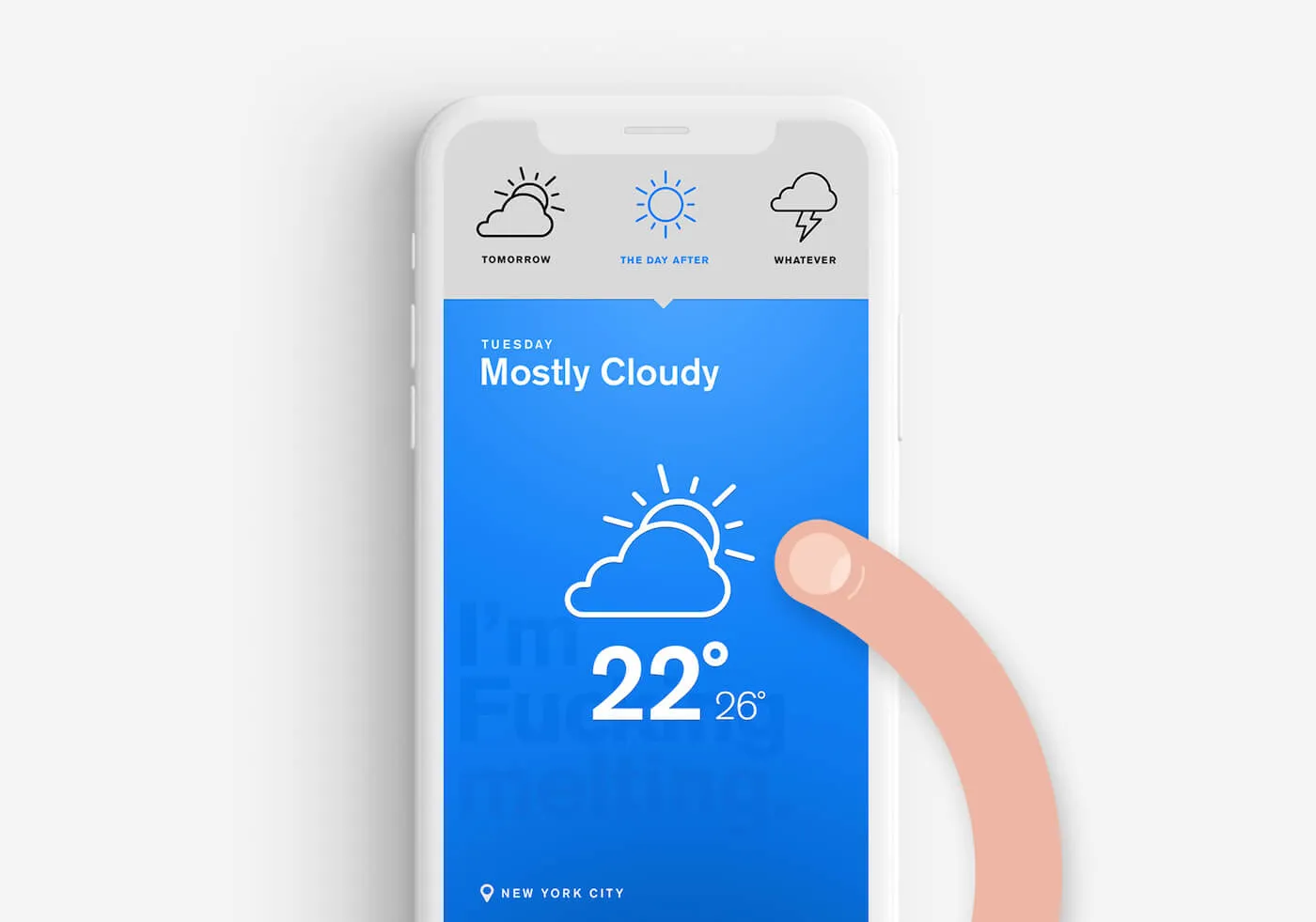
Now we’ve seen unique examples of social media communication, let’s tackle the strategy behind it.
Brand voice strategy process
A brand voice is a strategy that creates a unique way of communication for your chiropractic brand. Your communication will be appealing to your audience and will supercharge your social media presence.
The Brand Voice Strategy has two main stages
- Brand Voice Slider Exercise
- Tone Projection Exercise
Let’s start with the first one.
1) Brand Voice Slider Exercise
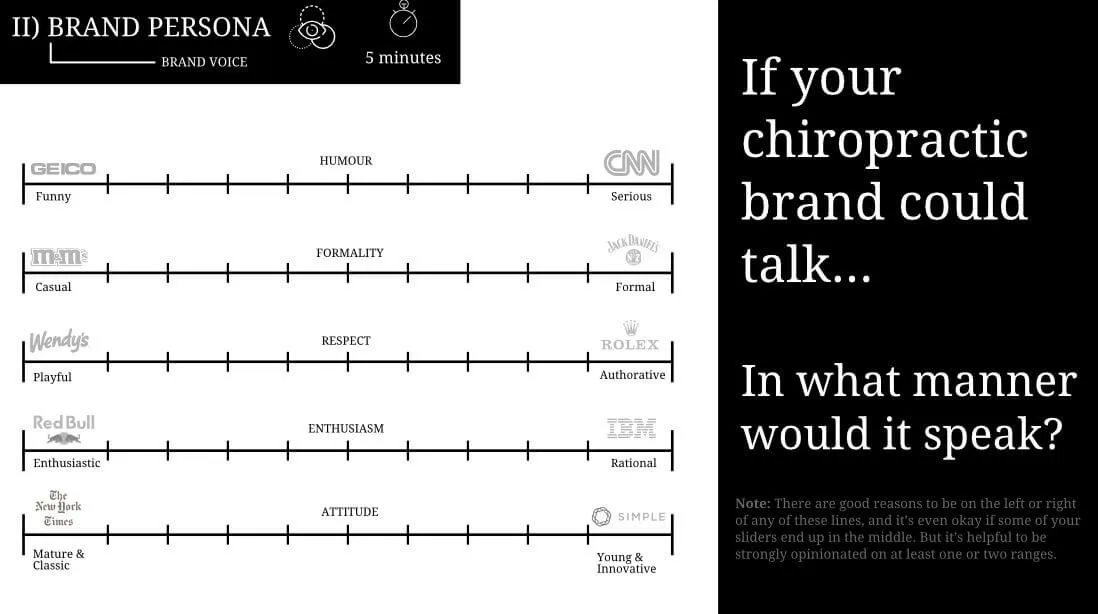
You can download PDF or print this exercise
for free here
.
This exercise helps you find a general manner of speech to your communication on social media. Does your brand come across as authoritative (Mayo Clinic) or serious-sounding (CNN)? Is it enthusiastic or humorous?
On the Brand Voice Exercise Slider, use voting dots to decide the voice of your brand.
Here’s Athletim™’s general brand voice:
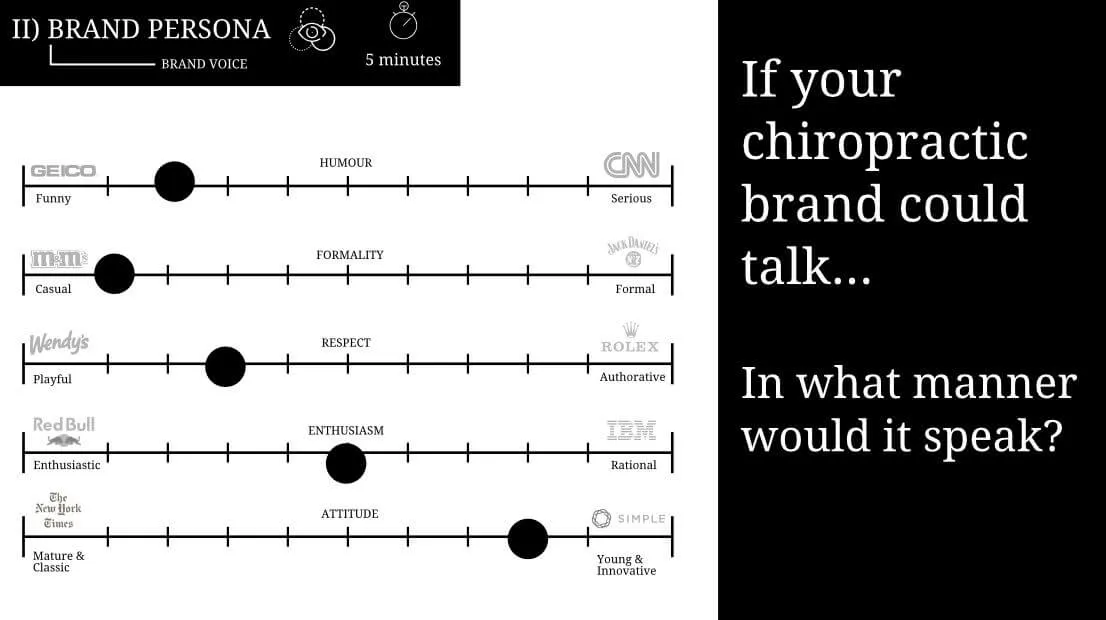
There are good reasons to be on the left or right of any of these lines, and it’s even okay if some of your sliders end up in the middle. But it’s helpful to be strongly opinionated on at least one or two ranges.
2) Brand Tone Projection Exercise
To solidify the voice of your brand, we’ll use the Tone Projection exercise.
We’ll project the voice of the brand across 4 dimensions of speaking : humor, formality, respectfulness, and enthusiasm.
The goal is to answer the following questions:
- How humorous will your communication be?
- How formal is your brand when talking?
- Level of respectfulness infused in a speaking manner, and;
- How enthusiastically the brand’s voice will be
The formula for this exercise is as follows:
We’re _______ But We’re Not ________.
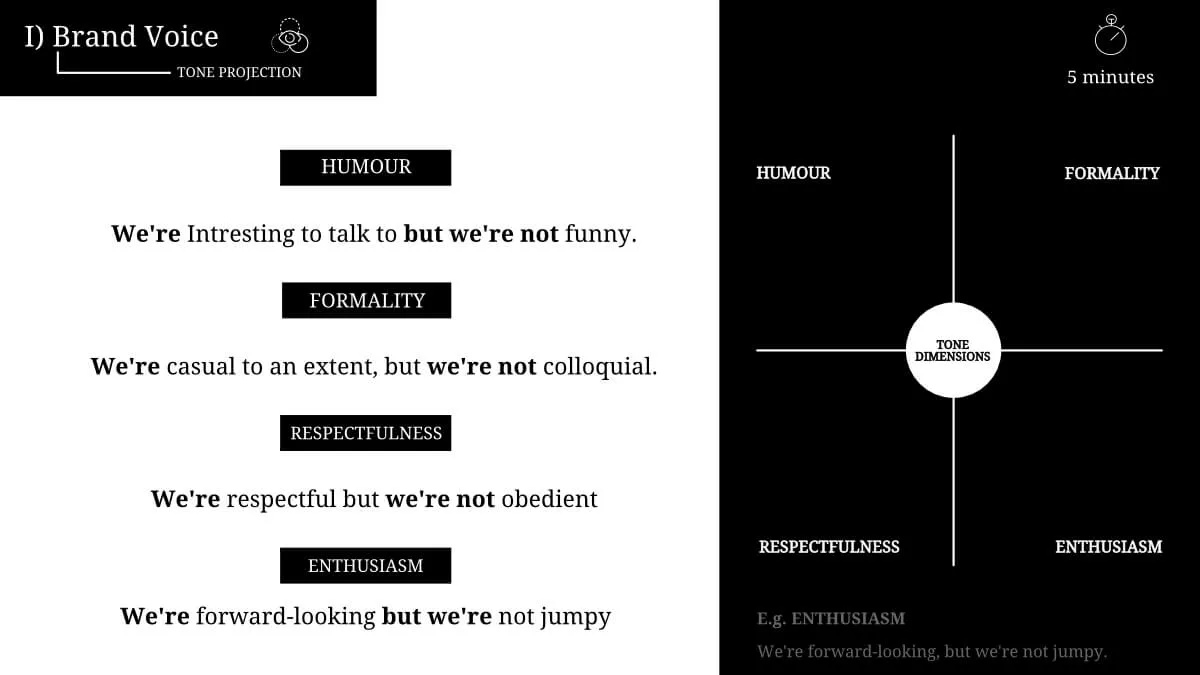
To download PDF or print this exercise
for free click here
.
You can also use sticky notes to write examples of how your brand voice can be applied across the 4 dimensions on the left side.
5) Brand Storytelling Strategy
Brand Storytelling is a strategy focused on marketing your chiropractic brand by telling stories around your business and what it stands for.
The beauty of this strategy is that it allows you to—asynchronously— narrate and market your practice in an easy to digest manner.
Instead of blasting your would-be patients with intrusive ads, we’ll use a more subtle way of reaching them.
To illustrate more, let’s get into the “how-tos”.
The Brand Storytelling Strategy consists of two parts
- Core Message And Secondary Messages
- Story Distribution Channels
1) Core Message And Secondary Messages
To promote your medical business in a story-based way, you’ll need a Main Narrative (Core Message) and subtopics (Secondary Messages).
Think of the Core Message as the theme of your marketing campaign and the Secondary Messages as the subtopics that make up the whole theme.
Let’s continue with our example Athletim™’s. their audience is athletes. So the Core Message and Secondary Messages will look like this:
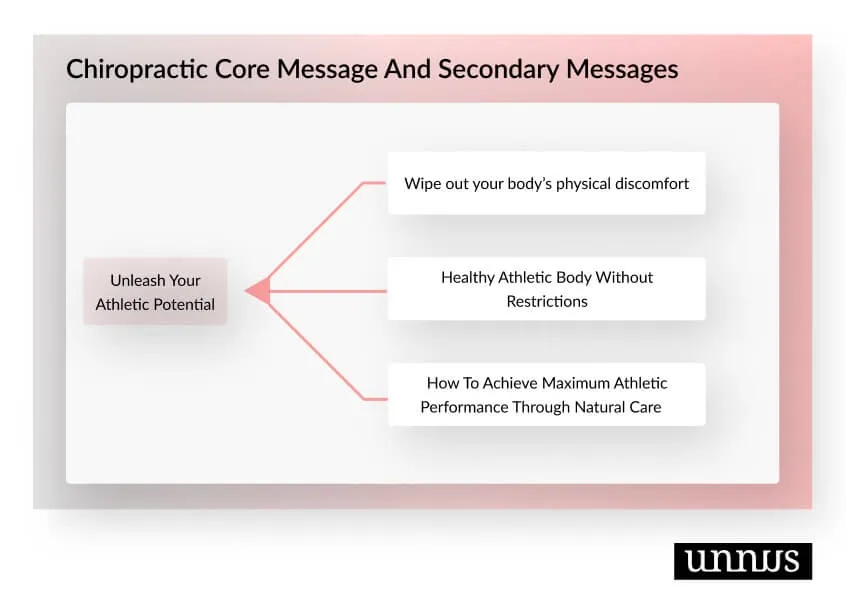
2) Story Distribution Channels
The secondary messages will be distributed in the form of media posts, articles, social posts, eBooks, brochures, and educational programs.
The following diagram represents how you will distribute these secondary messages to your patients:
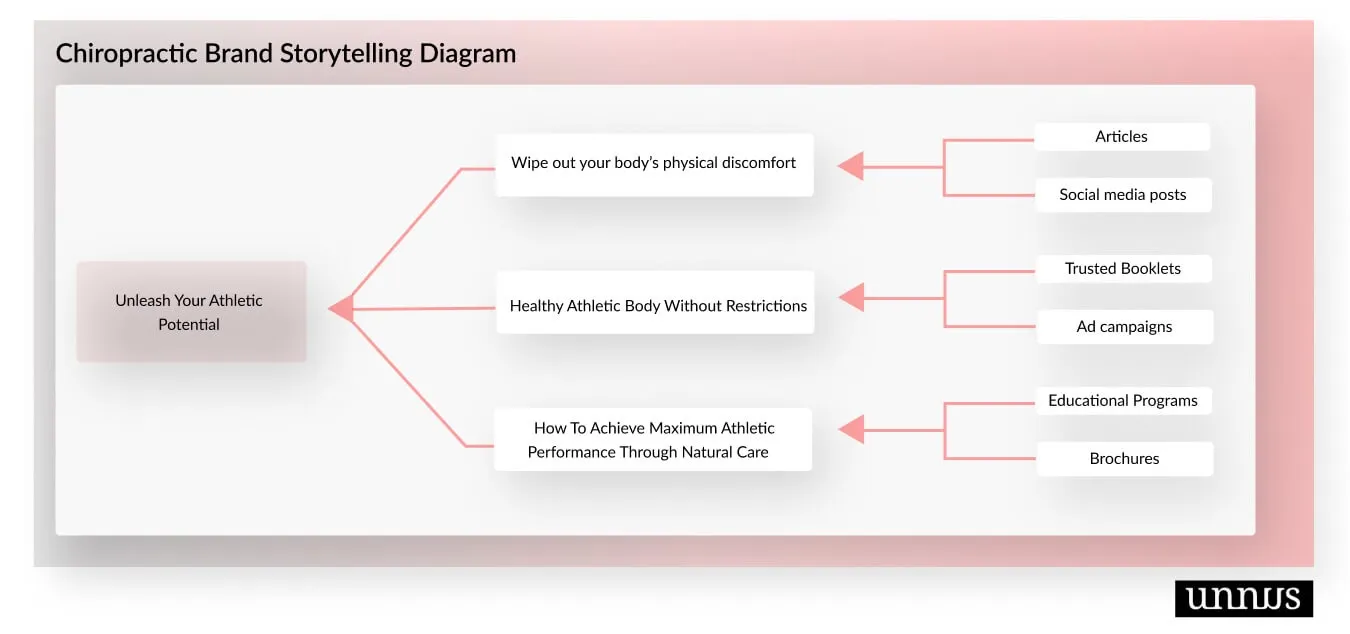
To decide which marketing channels work best for your promotional efforts, you can use our Channel Distribution Exercise™. It helps you see which ones benefit you more based on their impact and level of difficulty.

To download PDF or print this exercise for free click here .
6) Email Autoresponder Course Strategy
This strategy revolves around creating an email course by sending a premade sequence of emails to your subscribers as a form of lessons. The premise is that your potential patients will sign up for your free email series from your website and start receiving automated emails.
These emails are delivered as educational lessons. Each lesson holds valuable exercise or useful techniques that teach them about chiropractic care.
After your email subscribers finish your course, they’ll receive a pitch email that directs them to your online booking page to book you.
At this point, you helped them with useful content and built trust. So they will be more receptive to your bigger offer (one-on-one service).
Here’s a diagram of the path your potential patient takes until they book an appointment :

The goal of these lessons are manifold:
- To educate patients about the value of chiropractic care
- To help them solve their problems
- To build rapport and trust between you and subscribers and
- To encourage them to book an appointment with you
If you want to start applying this strategy, this video will be of great help:
7) Podcast Tours
One out of every five adults in the United States listens to a podcast regularly:

Compared to other ways of marketing your chiropractic business, guest podcasting is quicker and easier. A bit of prep time, 20 to 50-minute interview, and you’re done.
All you have to do is have a conversation and record it. It’s way less effort than having to make your video or audio. It’s also less stressful than going on live radio, as any mess-ups can be cut out in the edit.
There are hundreds of podcasts starving for guests. This is a great opportunity for you to pitch yourself as a guest and start gaining the spotlight.
Some benefits of being a guest on a podcast are:
- The podcast might be on health and wellness and the audience might be interested in natural care. If you can pitch your episode to a podcast where the audience is receptive to your services, it’ll be a great way to start building consistent leads.
- It increases your professional network and can be a great referral source.
- It expands the exposure of your chiropractic brand and gets more people interested in it.
- Since you’ll be on the show as a guest, you can promote your website or social media handles in the podcast. This is a great way to increase your online presence.
Let’s see how you can land your first episode.
1) Do your research
Start by researching podcasts you want to be a part of and you can add value to their listeners. To do that, you can start searching on popular platforms like iTunes, Spotify, Google Podcast, and Stitcher. There’s a lot of platforms but I’ll cover iTunes because it’s the largest one.
First, let’s go on how you find the contact email of the host so you can pitch them.
Log in to your iTunes. if you don’t have it, download it from here .
After you sign up, on the top-right search bar, type “Chiropractic Podcasts”. You’ll be faced with the following result:
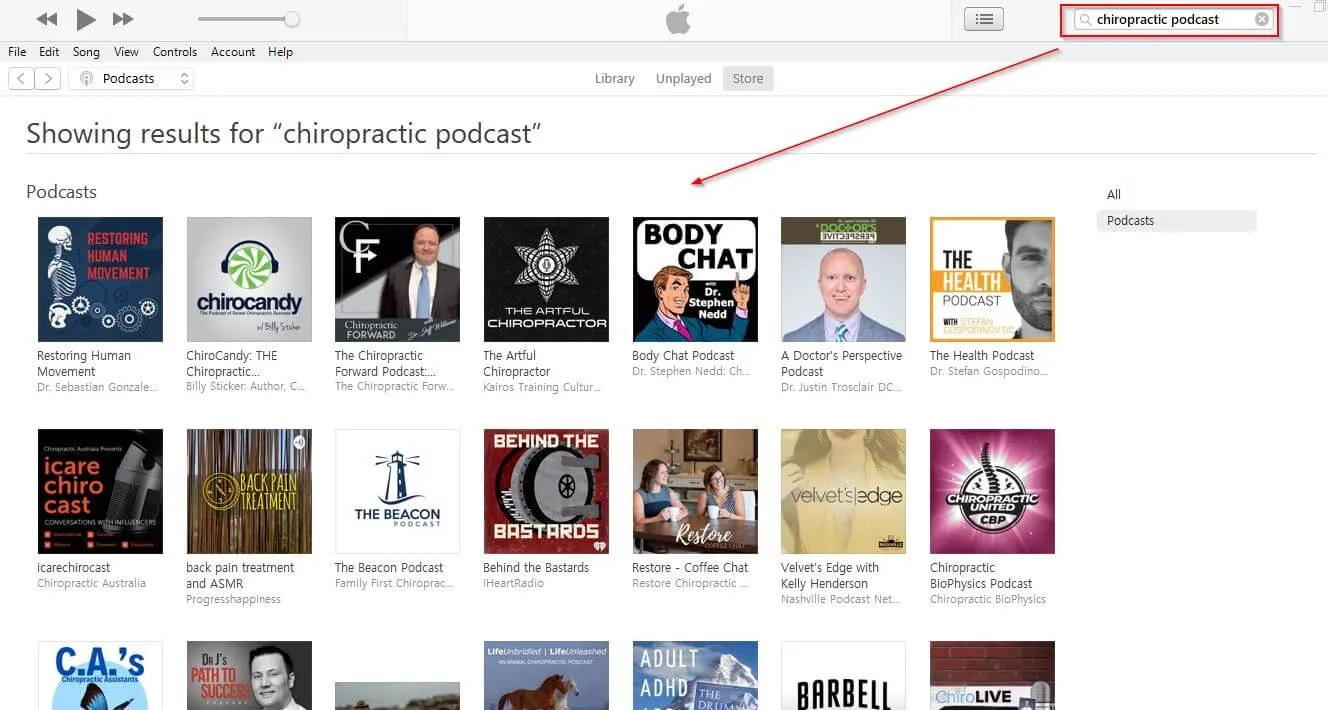
Click on one of the podcasts. In the podcast homepage on the left side, you’ll find the link section where you find the website link.
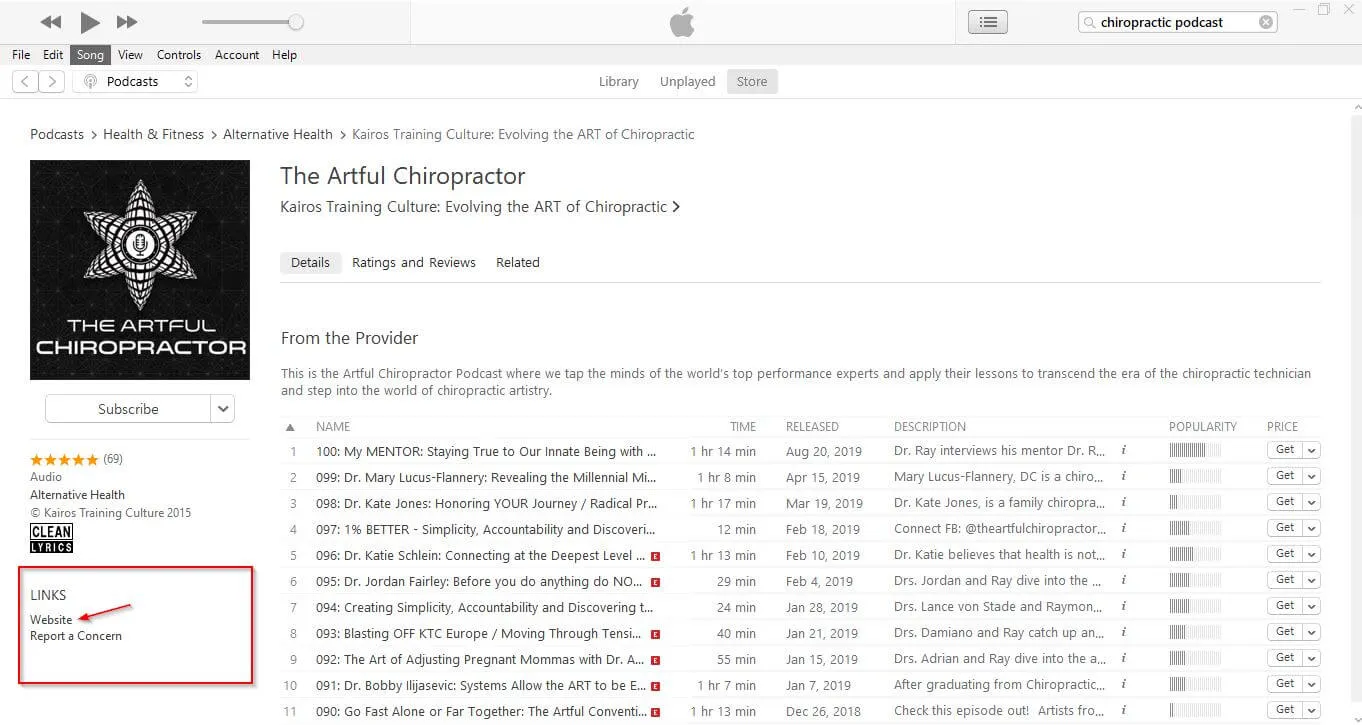
Click on the “website” label and it’ll direct you to the show’s site where you can find their contact information:

You might not always find an “email” icon so try to search for a contact form or “apply for our podcast” links.
You can also try to use services like Hunter to find emails from any particular website. Just enter the URL and it’ll find you the contacts.
2) Sending Your Episode Pitch
Now, it’s time to send the host a pitch for your episode.
Here’s a simple template you can use, feel free to modify as needed:
Subject: Podcast Pitch: How to [insert something likely to be of value to their audience]
Hi X,
A quick bit of background - [insert your area of expertise and credentials here]
I’ve been following your podcast for a while, and I enjoyed your recent interview with [X] on how to achieve [Y]. I’ve already had some success using some of the tips they mentioned.
I wondered if you might be interested in having me on your show to talk about [insert something likely to be of value to their audience]
Here’s what I could cover:
[Specific point/tip you can share]
[Specific point/tip you can share]
[Specific point/tip you can share]
Let me know your thoughts.
[Your name]
8) Speaking At Healthcare Conferences
Participating in industry-specific conferences can be an unexpected patient generation for your chiropractic business. In addition to increasing your sphere of influence, it can also lead to:
- Establishing you as an industry leader
- Being at the center of the stage and sharing worth-thinking-about ideas help solidify you as a pillar in the chiropractic field.
- Skyrocket your referrals
- One of the perks of being a public speaker is increased referrals from other practitioners. If you can demonstrate the value of chiropractic in healthcare conferences, other doctors will start referring patients to your practice for natural care.
- Increased exposure for your brand
- Many healthcare professionals use public speaking as a way to increase awareness of their practice. Sharing how your practice transformed your patient’s life and what positive impact your brand has on your community is a great way to build awareness.
- Career advancement
- Speaking at conferences help you with career advancement, as it shows creative abilities, critical reasoning, leadership skills, poise, and professionalism, properties that are valuable in the healthcare industry.
Participating in conferences can be hard at first but it pays dividends in the long run. If you have a unique way of how the chiropractic industry should change or a thought-provoking idea, sharing it with industry professionals helps you and your business grow.
9) Honorable Mentions
I didn’t want to cover what’s “already out there” because there’s already enough resources for other marketing strategies. So I left the rest an honorable mention.
Here are some other marketing ideas you can implement to grow your chiropractic business:
- SEO and Content Marketing
- Content marketing is a strategic marketing approach focused on creating and distributing valuable, relevant content to attract and retain patients from multiple channels like Google, Youtube, and other platforms.
- PPC & Paid Advertising
- PPC stands for pay-per-click, a model of internet marketing in which advertisers pay a fee each time one of their ads is clicked. It’s a way of buying visits to your chiropractic website.
- Online PR
- Online Public Relations is a way to communicate with potential patients for your chiropractic business in the online public realm. One way to implement this strategy is to get featured in health and wellness digital magazines.
- Target the Online Communities
- Online communities can be a way to grow your online presence and to catch insights. Being around people with similar interests and exchanging medical knowledge develops relationships for your business.
The ‘secret’ to an effective chiropractic marketing
Your marketing effort is as good as the branding behind it. For your chiropractic business to thrive, it needs battle-proven positioning and solid brand DNA behind it.
Marketing should never be conducted without a proper brand strategy for your chiropractic business. Your marketing communication needs a unique voice to speak to your patients. This not only sets you apart but it gets you out of the market clutter.
If you’d like to know more about branding in healthcare, you can check our free guide here .
But if you’d like to have some help with your brand differentiation, strategy, and communication, you can always say hello to us . We’ll gladly help.


